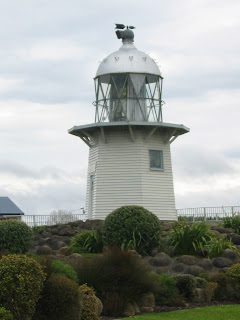
The land gets flatter and flatter and the hills form a deep green bowl as you drive into Napier. It seems to have sprawled since we were last here and it was only as we came to the centre that I recognised it.


The Esplanade was as splendid as ever and filled with scented flowers at this time of year. The blue and white fountain was blowing everywhere as the wind was picking up when we arrived. We watched the orange dredgers in the harbour and found our Beach Cottage, right on the sea, with every modern comfort we could want, even pale yellow orchids growing in the garden – I guess that proves the climate is different here. We had freshly baked pizzas for dinner and hot chocolate with marshmallows before bedtime.


The next morning we knew we had little to no driving in front of us, so we headed for town and the Museum. The Museum has, for some reason, a corrugated iron gorilla, holding an ice-cream, peering over the top of it?
It’s crazily reminiscent of the statue of liberty, only more frightening!

Anyway, inside the Museum if you venture downstairs there is a film running, in a tent, with ‘survivor’ stories from the earthquake and a clear, but worrying display of what causes earthquakes and where New Zealand is, in relation to the fault lines. I think the title was ‘Something’s Got to Give!’


Once outside it was slightly unreal to walk down the High Street, having seen the film of its total destruction. We visited the Panui statue and Tourist info. To find out about the art deco tours and vineyards.

There is a festival here in February where everyone re-enacts the 1930s and dresses up in the fashion of the time and drive their old cars into town. It looks fabulous!
After lunch we decided, despite the wind, to attempt the Whakamaharatanga Walkway, up to the pa. The steep walkway takes you along the ridge of a hill which used to be an island in the middle of a lagoon.
When the earthquake happened the ground manoeuvred so high, that the island was lifted out of the lagoon and became joined to the peninsula. The lagoon then disappeared altogether and everyone began to use the land.

Tangoio Beach, was our next stop after that, to look at possible fishing sites. Greg brought the kayak and is hoping to catch us some fish for the barbeque tomorrow. Returning to our little haven we bought freshly picked apples from a local stall and Sophia made apple pie! We ate it with lots of ice-cream.
Early start tomorrow.





















































